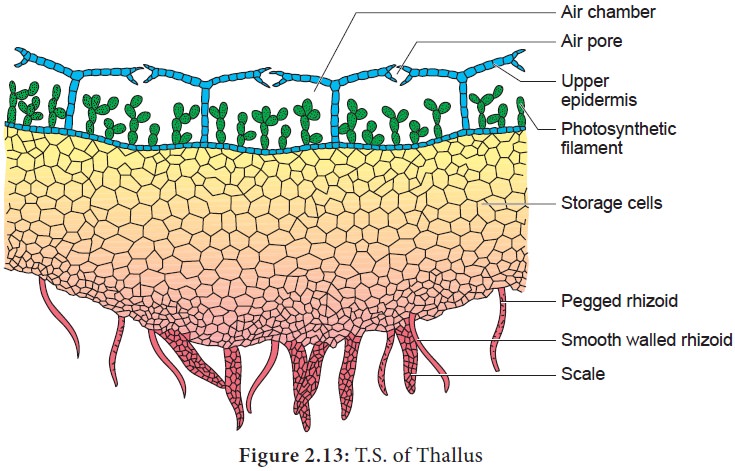Chapter: 11th Botany : Chapter 2 : Plant Kingdom
Marchantia - Bryophytes

Class - Hepaticopsida
Order – Marchantiales
Family - Marchantiaceae
Genus - Marchantia
Marchantia
grows in
cool moist shady places. Marchantia polymorpha is the common
species.
Gametophyte
The plant body of Marchantia is a gametophyte. It is prostrate,dorsiventral and
dichotomously branched. The thallus on the dorsal surface possess conspicuous
median midrib which is marked by a shallow groove on dorsal surface. The dorsal
surface appears to have rhomboidal or polygonal diamond shaped areas which
indicate the outline of the underlying air chambers of the thallus (Figure 2.12).

Figure
2.12: Marchantia
a)
Thallus with antheridiophore
b)
Thallus with archegoniophore
The dorsal surface also shows crescent shaped
structures called gemma cups which contain vegetative reproductive structures
called gemmae. The apical notch bears an apical cell which helps in the growth
of the thallus.The ventral surface the thallus bears multicellular scales and
rhizoids which help in fixation and absorption of water and minerals. The
rhizoids are of two types namely smooth walled or pegged (tuberculate) type. On
maturation the thallus bears erect antheriophores and archegoniophores.
Internal structure of Thallus
In transverse section the Marchantia thallus shows three parts namely: Epidermis,
Photosynthetic region and storage region (Figure
2.13).

The epidermis has the upper and lower layers. The
upper epidermis is single layered with thin walled parenchymatous cells. The
cells possess chloroplasts. The upper epidermis is interrupted by many barrel
shaped air pores which communicate with the air chambers. The pore is
surrounded by 4 to 8 superimposed tiers of cells. Below the upper epidermis a
number of air chambers are present in a single horizontal layer.The air
chambers are separated from one another by partitions which extend from the
epidermis to the floor of the air chambers. The floor of the chambers bears
simple or branched green filaments. The cells of the filaments are involved in photosynthesis.
The photosynthetic region is followed by storage region. It is made up of
several parenchymatous cells arranged without intercellular spaces. The cells
of this region contain starch grains and protein granules. The lower epidermis
possesses rhizoids and multicellular scales.
Marchantia
reproduces
by vegetative and sexual methods.
1.Vegetative Reproduction
Vegetative Reproduction takes place by
progressive death and decay of thallus, formation of adventitious branches and
by germination of gemmae. Death and decay of the thallus starts from posterior
end .When it reach the point of dichotomy , two apical parts of the thallus get
separated. Each one develops into an independent thallus. Adventitious branches
are produced on the ventral surface of the gametophyte. The branches get
separated from the parent thallus and grow into independent gametophytes.
Gemmae are specialized multicellular asexual reproductive bodies. They are
formed in small cupules known as gemma cups, present on the dorsal surface of the
thallus. Usually the gemmae present on the male thallus form male plants and
those on the female thallus give rise to female plants (Figure 2.14).

Vegetative reproduction in Marchantia
2. Sexual reproduction:
In Marchantia,
sex organs are borne on special stalked receptacles called the gametophores.
Those bearing antheridia are called antheridiophores and archegonia bearing
structures are called archegoniophores (Figure
2.15). Marchantia is heterothallic or
dioecious. i.e., male and female
receptacles are present on different thalli. The sex organs in bryophytes are
multicellular. The male sex organ is called antheridium. It produce
biflagellate antherozoids. The female sex organ is flask shaped called
archegonium and produces a single egg. Water is essential for fertilization.
The antherozoids are released into water and are attracted towards archegonium
through chemotaxis. Although many antherozoids enter the archegonium, only one
fuses with the egg to form zygote. The zygote represent the first cell of the
sporophytic generation. Zygote develops in to a multicellular structure called
sporophyte. (Figure 2.16).


The sporophyte is not free-living but attached to
the photosynthetic gametophyte and derives nutrition from it. Sporophyte is
differentiated into foot, seta and capsule. The foot is bulbous and is embedded
in the gametophyte. It derives nutrition from the gametophyte and transfers to
the sporophyte. Seta is short and connects foot and capsule. The capsule
consists of single layered jacket layer and encloses numerous haploid spores
and elaters. The capsule is covered by protective covering called calyptra. On
maturation the capsule dehisces and spores are released. Elaters helps in the
dispersal of spores. The spores under favourable conditions germinate and
develop into new gametophyte. The haploid gametophytic phase alternates with
diploid sporophytic phase, thus the life cycle of Marchantia shows alternation of generation (Figure 2.17).

Related Topics